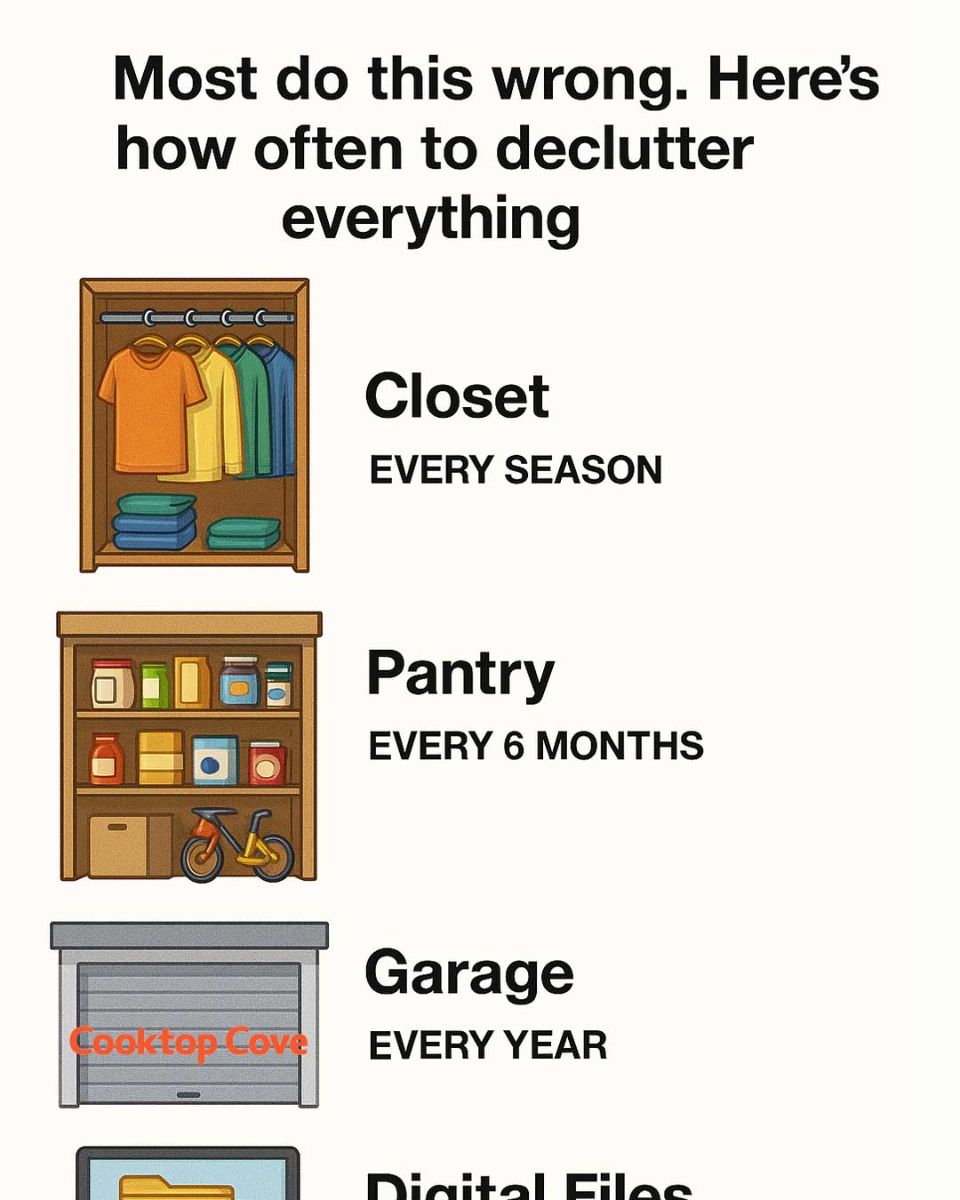Most do this wrong. Here’s how often to declutter everything
Georgia Lynn
Contributing Writer
Print this recipe
In today’s fast-paced world, clutter can quickly accumulate in our homes, leading to stress and disorganization. Many people struggle with maintaining a tidy living space, often feeling overwhelmed by the sheer volume of items they own. Decluttering is not just about tidying up; it’s about creating a more functional and peaceful environment that enhances your quality of life.
Despite its importance, decluttering is often misunderstood and improperly executed. People tend to either declutter too infrequently or approach it in a way that doesn’t address the root of the problem. This article aims to provide a comprehensive guide on how often to declutter various areas of your home and offers practical tips to make the process more effective and less daunting.
1. The Importance of Regular Decluttering
Regular decluttering is crucial for maintaining a clean and organized home. Studies have shown that clutter can increase stress levels and negatively impact mental health. By routinely removing unnecessary items, you can create a more serene and efficient living space. Experts recommend decluttering different areas of your home at regular intervals to prevent the buildup of clutter.
For instance, a survey conducted by the National Association of Professional Organizers found that 54% of Americans feel overwhelmed by the amount of clutter they have, and 78% have no idea what to do with it. Regular decluttering can help alleviate these feelings by ensuring that your home remains a place of comfort and relaxation.
2. Why Most People Get Decluttering Wrong
Many people approach decluttering with the wrong mindset, treating it as a one-time event rather than an ongoing process. This often leads to a cycle of decluttering followed by rapid re-cluttering. Another common mistake is focusing solely on visible areas while neglecting hidden spaces like closets and drawers, which can quickly become disorganized.
Additionally, people often underestimate the emotional attachment they have to their belongings, making it difficult to let go of items they no longer need. This emotional barrier can hinder the decluttering process, leading to frustration and incomplete results.
3. How Often to Declutter Your Closet
Closets are one of the most frequently cluttered areas in a home, and they require regular attention to stay organized. Experts recommend decluttering your closet at least twice a year, ideally at the change of seasons. This allows you to assess your wardrobe and remove items that are no longer in style, don’t fit, or haven’t been worn in the past year.
To effectively declutter your closet, start by removing all items and sorting them into categories: keep, donate, and discard. Be honest with yourself about what you truly wear and need. This bi-annual routine will help keep your closet manageable and ensure that you only keep items that you love and use.
4. Seasonal Closet Hacks for Easy Decluttering
Seasonal changes provide the perfect opportunity to refresh your closet and streamline your wardrobe. One effective hack is to use the ‘hanger trick’: at the beginning of the season, turn all your hangers backward. As you wear and wash clothes, return them to the closet with the hanger facing the correct way. At the end of the season, any clothes still on backward hangers should be considered for donation or sale.
Another tip is to create a capsule wardrobe for each season, consisting of versatile pieces that can be mixed and matched. This not only simplifies your daily outfit choices but also reduces the overall number of items in your closet, making it easier to maintain.
5. The Six-Month Pantry Purge: A Guide
The pantry is another area that can quickly become cluttered with expired or unused items. A six-month purge is recommended to keep your pantry organized and ensure that all food items are fresh and safe to consume. Begin by removing everything from the shelves and checking expiration dates. Discard anything that is expired or no longer desired.
After purging, categorize items by type (e.g., canned goods, grains, snacks) and store them in clear, labeled containers. This not only makes it easier to find what you need but also helps you keep track of inventory, reducing the likelihood of over-purchasing.
6. Viral Pantry Organization Tips
Social media platforms like TikTok and Instagram are full of viral pantry organization tips that can transform your space. One popular method is using uniform storage containers for dry goods, which not only looks aesthetically pleasing but also maximizes space. Labeling each container with its contents and expiration date ensures that you always know what you have on hand.
Another trending tip is to use tiered shelving or lazy Susans to make the most of vertical space and keep items easily accessible. These simple yet effective strategies can turn a chaotic pantry into a well-organized and functional space.
7. Annual Garage Clean-Up: What to Keep and What to Toss
The garage often becomes a dumping ground for items that don’t have a designated place in the home. An annual clean-up is essential to prevent it from becoming overly cluttered. Start by categorizing items into keep, donate, and toss piles. Be ruthless in your decision-making, especially with items that haven’t been used in the past year.
Consider installing shelving units or pegboards to organize tools and equipment, making them easily accessible. For seasonal items like holiday decorations or camping gear, use clear bins with labels to keep everything organized and visible. This annual routine will help maintain a functional garage space.
